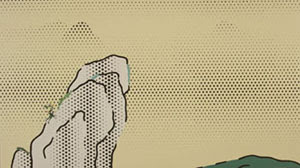
If he appropriated or stole his images and ideas is still a matter which many who see his paintings have strong differing opinions about. We hope that while you visit this exhibition you will consider these questions and ideas while you gain a clearer understanding of what artistic appropriation is and perhaps gain an opinion of your own about whether Roy Lichtenstein was a thief or not.
Image Description: Whaam! 1963. Magna on two canvases. 5.67x 13.33ft. Courtesy of the Tate Gallery, London.
In the image that appears on these two painted canvases is a dynamic quality of action and excitement. Here, Lichtenstein draws inspiration from wartime and action comics. He uses the comic art style as a way of making the subject matter of a plane shooting down another less serious. Even though he chose the subject of war in order to make small commentary, his main purpose was to also exhibit the style’s simplified structure and reduction of forms.
Removing parts of the background and other planes from the source image, Lichtenstein sharpens the focus of the composition to be on the action and broad areas of color. He even moved the caption to better fit his artistic intention for the composition and completely removed the speech balloon of the pilot in the left fighter plane. Even with all of these changes, when one sees the comic book panel and then compares it to the painting by Lichtenstein the obvious similarities between the two images cannot be ignored.
Removing parts of the background and other planes from the source image, Lichtenstein sharpens the focus of the composition to be on the action and broad areas of color. He even moved the caption to better fit his artistic intention for the composition and completely removed the speech balloon of the pilot in the left fighter plane. Even with all of these changes, when one sees the comic book panel and then compares it to the painting by Lichtenstein the obvious similarities between the two images cannot be ignored.
Image Description: Bedroom at Arles. 1992. Oil and magna on canvas. 10.5x 13.75ft.
Lichtenstein's
In this rather large painting, Lichtenstein attempts the subject of Vincent Van Gogh’s painting, Bedroom. In Lichtenstein’s version of the room, most of the objects, including the bed and chairs, are all in about the same position. The room still has a window, blue walls, and a yellow bed with a red blanket. Lichtenstein does however recreate the scene in his comic influenced style. The green floor in his image still looks like it is meant to be made of wood; however his floor is a pattern of wood grain, not actually boards of wood. The floor is also not in perspective as is the room, but instead an apparently flat design. His furniture and objects in the room are modern counterparts of those found in the Van Gogh painting. Where Van Gogh’s version is painterly with visible brushstrokes, Lichtenstein’s version is crisp without visible marks of the brush. His industrial approach in some ways lends his version a less lifelike quality.
Still, it could be said that just as Van Gogh painted the scene as seen through his impressionistic lens, Lichtenstein, in the same manner, has painted the scene through the lens of industry and popular culture.
Still, it could be said that just as Van Gogh painted the scene as seen through his impressionistic lens, Lichtenstein, in the same manner, has painted the scene through the lens of industry and popular culture.
...God Bless and have a good one!
Part One can be read HERE. (Please ask for permission before reproducing.)
EDIT: It's been quite sometime since I wrote this hypothetical exhibit proposal. Since then my own personal view about Lichtenstein's early "comic art" and all of his work in general has changed often in various ways. This piece I've written, however is still meant only to clarify some things about his work and move the reader to ask themselves what they think.




It is interesting to read the website on
ReplyDeleteeugeneboch.com ... who is represented in the first painting above the bed next to Paul Eugene Millet. Looks like if Vincent van Gogh and Eugene Boch had a little Love affair back in 1888.
OMG. I just went to a Lichtenstein show at the MORGAN, came home, got online to look at other pieces of his - & thank goodness I found this submission otherwise I wouldn't have known where he got his inspiration. :-)
ReplyDeleteThanks for posting this comparison, otherwise I would have had no idea where Lichtenstein had gotten his inspiration from. :-)
ReplyDeleteThanks! and you're welcome! Yeah, I tend to grab or appropriated smidgens of other stuff for a lot of my work, so as I did this research I found it very interesting and exciting. Its also intresting to hear different people's opinions about it.
ReplyDeleteShow at the MORGAN= you're lucky!
appropriation has a long history in art. the examples of stealing or appropriating are two many to count...michelangelo, rembrant, van gogh, picasso on and on. there is no place for footnotes in art and yet artists must be able to reference the past in order to react to it. the artists motive is primary, in Lichenstein's case parody, appropriation is just the tactic. the new context or intent of the artist justifies the appropriation.
ReplyDelete